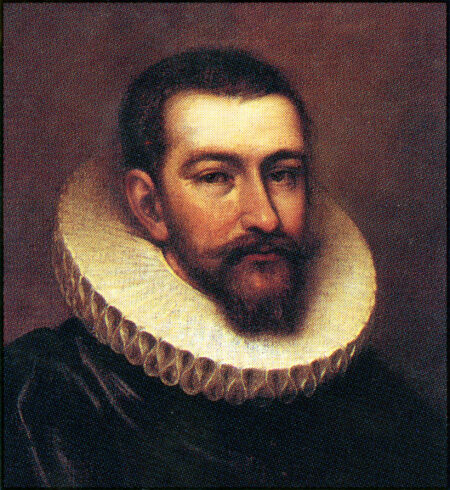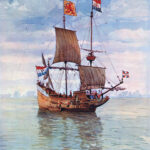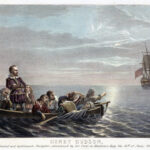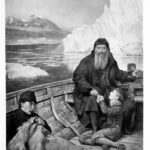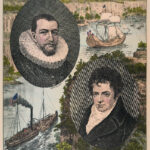Henry Hudson
Explorer
Age of Discovery
Quick Facts:
English captain and navigator who discovered the Hudson River, Hudson Strait and Hudson Bay and sailed through parts of the Arctic on his search for a Northwest Passage to China
Introduction
Henry Hudson made four voyages in search of a water route to the Far East. His first two voyages were through Arctic waters and proved to be unsuccessful due to ice. His third and fourth voyages were to North America where he discovered and sailed the Hudson River, Hudson Strait, and Hudson Bay. Henry Hudson’s discoveries influenced other explorers and laid the foundation for future colonization and trading.
Biography
Early Life
Not much is known about Henry Hudson’s early life prior to his first significant voyage in 1607. Most historians believe he was born around 1565 in England, and lived for some time in London.1 He would have received a good education, because it is known that he could read, write, and do mathematics. Most scholars believe that Hudson’s grandfather was one of the founders of the Muscovy Company. This was a very important trading company of this time, and would be the reason Hudson would go on his voyages. It is very likely that Henry worked on ships from a young age, probably as a cabin boy. He would have learned how to cook, handle sails, care for a ship, and keep a ship’s log.2 He would also have learned navigational skills as well. It is not exactly known when, but at some point, Hudson married a woman named Katherine and they had three sons – Oliver, John, and Richard.3 His son, John, would join him on all four of his voyages.
It is thought that Hudson sailed with fellow explorer John Davis in 1587. On Davis’s voyage, they sailed to the Arctic in search of the Northwest passage. Trade and commerce were two motivations for explorers during the 17th century. Much of the world had been mapped and settled by various countries. But the possibility of a sea route on top of the world was still unknown. Many countries in Europe were continuing to search for quicker passages to Asia. The desire for faster routes to Asia was driven by the demand for different goods, such as spices. The Muscovy Company was no exception. They had ships and a crew, but no one to captain the voyage. Richard Hakluyt, a respected priest and scholar, recommended Hudson for the job.4 Before then, Hudson only had experience as a navigator, not a captain. But In 1607, Hudson was commissioned by the Muscovy Company lead a journey to sail across the Arctic Circle to China.
Voyages
Principal Voyage
Henry Hudson sailed out of Gravesend, England in April 1607 aboard the ship Hopewell. He had a crew of ten men, including his son John. It was a slow trip with bad winds. It took 26 days to reach the Shetland Islands north of Great Britain. Then another week and a half to reach the Arctic Circle.5 Not only was the weather difficult, but along the way, he had trouble with some of his crew members. Hudson demoted two experienced men: first mate William Collins and James Young. John Colman replaced Collins as first mate.6 This upset many of the crew, and would possibly lead to trouble for Henry Hudson later on. They sailed past Greenland’s coast into heavily ice packed waters. They continued toward the North Pole and reached Spitsbergen in the Svalbard archipelago (part of Norway). Along the way they saw many whales, some seals and walruses, and several species of seabirds. He made several attempt to sail around the ice packs, but was unsuccessful. On July 27, the Hopewell and her crew headed back towards England. Hudson had failed to find his northern route to China.
The Muscovy Company was excited to hear about the whales Hudson saw in the arctic. Whaling in the 17th century was very profitable. Whale meat and fat were used to make oils that helped burn candles. The Muscovy Company quickly made plans to begin a whaling expedition.7 But Hudson was not interested in whaling, he was interested in exploration. So in 1608, the Muscovy Company commissioned Hudson once again to find passage to the Far East. This time, Hudson planned to find a Northeast passage, sailing towards the Russian region of Novaya Zemlya. Hudson left on April 22, 1608 aboard the Hopewell once more, with a crew of 14 men, including his son John again.8 Hudson had trouble once again with several of his crewmen. But they continued onward, and reached Novaya Zemlya. They saw several animals again, and Hudson even recorded in his journal seeing a mermaid. But like his last journey, Hudson could not navigate past the large ice packs and returned to England.
Subsequent Voyages
The men of the Muscovy Company were unhappy with Hudson’s results. So they denied him the chance to make another voyages. So Hudson turned to the Dutch. He went to Amsterdam, and was commissioned by the Dutch East India Company in 1609 to find a Northeast passage to Asia. He sailed from Holland aboard the ship Half Moon on April 6, 1609. Not far above Russia, Hudson and his men were once again blocked by heavy ice packs. Hudson chose to ignore his orders from the Dutch, and instead headed in search for the Northwest passage. He crossed the Atlantic Ocean, made his way down Newfoundland and Nova Scotia in Canada. Continuing onward, he passed the sites that would become Plymouth and Boston (in present day Massachusetts). They made it as far down to the British settlement of Jamestown, Virginia.9 They then turned back around, heading north, and entered into a river in present day New York. Hudson was hopeful this was the passage he had been looking for. This is the same area Giovanni da Verrazzano had explored previously in 1524. Hudson traveled 150 miles up this river, but found it was not the passage as he had hoped. This river would become known as the Hudson River. The expedition followed the river until the crew determined that it did not lead out to the Pacific Ocean. They headed back to Europe.
On his return to Holland, the Half Moon docked at Dartmouth, England. The English, who had poor relations with the Dutch, did not allow Hudson to return to Holland. He had to send his log book of information on without him. During this time, Hudson was one of the most experienced captains of Arctic exploration in Europe.10 So they called on him once more to go back in search of a Northwest passage. Hudson, his son John, and Hudson’s crew set sail on the Discovery on April 17, 1610. They sailed across the Atlantic, reaching northern Canada, and then heading for the Hudson Strait. They soon found themselves in James Bay, at the southernmost part of the Hudson Strait. But they found no outlet leading to the Pacific Ocean towards Asia. After searching for sometime, they were forced to remain there as the Arctic winter set in. During these winter months, tension between Hudson and his crew would lead to a sad fate.
Later Years and Death
Hudson and his crew spent the winter in James Bay since they were unable to sail through the icy waters. By June 1611, the Discovery was free of ice and could continue on her journey. But by the end of winter, the crew had only grown more upset with their captain. Many of them felt that their trip was a waste of time. In June 1611, Robert Juet, after being demoted as mate, led a mutiny against Hudson. Hudson, his son, and several sick crew members were sent adrift in a small boat. What became of the castaway men is still unknown today.
Legacy
Henry Hudson was a determined captain, explorer, and navigator. He sailed through the uncharted, dangerous icy waters of the Arctic. But his poor leadership skills led to his unfortunate end. Although he never achieved in finding a passage to Asia, Hudson discovered various North American water routes. His discoveries led other Europeans to journey to North America where colonization and trading would take place. Many of the areas that he explored and sailed through are named after him today. A strait, a bay, and a river – the Hudson River in New York – are all named after him.
EndnotesImages

